
ISSN: 2321-9653; IC Value: 45.98; SJ Impact Factor: 7.538 Volume 10 Issue XII Dec 2022- Available at www.ijraset.com



ISSN: 2321-9653; IC Value: 45.98; SJ Impact Factor: 7.538 Volume 10 Issue XII Dec 2022- Available at www.ijraset.com

Reshma Kale1 , Vaishanavi Sarode2 , Vaishnavi Bidarkar3 , Soni Singh4 , Prof. Prachi Nilekar5 Alard College of Engineering & Management, (ALARD Knowledge Park, Survey No. 50, Marunje, Near Rajiv Gandhi IT Park, Hinjewadi, Pune-411057) Approved by AICTE. Recognized by DTE. NAAC Accredited. Affiliated to SPPU (Pune University) Abstract: Trying on different clothes in the store and finally choosing the right one can be a time-consuming and tedious process. So, a real- time virtual fitting room is a concept where a customer can buy pieces of her clothes without having to wear them. The virtual fitting room environment is the online equivalent of her fitting room in a store. People usually avoid buying wearable clothes online. To solve this problem, I decided to create an online test room application. Our research involves recording a video of user using the system camera, segmenting the video into indivi-dual frames to extract user’s body, and developing an application that transforms, rotates, and makes wearable. is focused on as image that scales in real time to fit the user Virtual try-on technology lets customers see how clothes fit themselves or an avatar, allowing them to virtually “try on” clothing before purchasing them. This method helps avoid challenges connected with conventional e-commerce sales channels, such as fit issues and environmental and financial returns costs.
Inmodernlife,peopleprefertousetopurchaseitems,andoneofthemisclothes.However,oneofdisadvantagesofonlineclothesshoppingis thatitcannotprovideaphysicaltry-on.Thus,onedoesnotknowhowmuchchosenclothesisfittedintoone’sbodyinsize,style,coloretc.Even thoughtheyworkwell,theyhavefundamentalpracticalweaknesssincetheyneed3Dclothesmodelswhichrequiresnon-negligibleamountof timeforconstructing.Thus,recently,image-basedvirtualfittingsystemsdevoidof3Dclothesmodel,hasattractedalotofresearchattentionand arisenasalternativepromisingvirtualfittingsystems.You have tostandin front ofthe camera. With thehelp ofalgorithms, cameras scan thehuman bodyfrom the environment. Awebcam anda monitor connected tothedevice processor presentthe consumer with a virtual clothinglist. Awebcamscansthesceneanddisplayslive videostreaminginawindow. Alistofclothesthattheuser shouldwearisalso displayed on the monitor. When the user selects an address, a dress is selected and the user virtually wears it
Machine learning allows the user to feed a computer algorithm an immense amount of data and have the computer analyze and make data-driven recommendations and decisions based on only the input data.it perform the task as per expected result
MPV(Multi-PoseVirtualtryon)dataset, which consistsof 37,723/14,360person/clothesimages, withtheresolution of256x192.Each person has differentposes. Dataset isa collection ofdata or relatedinformation thatis composed for separate elements. A collection of datasets for e-mail spam contains spam and non-spam messages
MPV (Multi-Pose Virtual tryon) dataset, which consists of37,723/14,360 ... We split them intothe train/test set 52,236/10,544 threetuples, respectively. that training data is the subset of original data that is used to train a machine learning model, whereas test data is used to check the accuracy of the model
When workingonvirtualfittingroomapps, weconductedaseriesofexperimentswith virtualtryon clothesandfoundoutthattheproper renderingofa3Dclothesmodelon aperson stillremainsachallenge. For aconvincingARexperience, thedeeplearningmodelshould detectnotonlythebasicsetofkeypointscorrespondingtothejointsofthehuman body. Itshouldalsoidentifythebody'sactualshapein threedimensionssothattheclothingcouldbeappropriatelyfittedtothebody. thefittingroomsarealways full, withlonglinesespecially duringpeakholidays. Even justtryingonafewclothesresultsin longqueues, whichleadstocustomer dissatisfaction.Infact,acustomer choosesclothingshoppingstyles, onlineshoppingfor her or in-store, dependingontheir specificneeds. However,neithermeasurefalls shortofthegoalofallowingcustomerstoseethesize, fit, orstyle oftheirfavoriteclotheswithoutactuallytryingthemon.Therefore,this project proposes a virtual AR dressing room to help customers achieve their shopping goals.
ISSN: 2321-9653; IC Value: 45.98; SJ Impact Factor: 7.538 Volume 10 Issue XII Dec 2022- Available at www.ijraset.com
Developing an automated clothes trial system
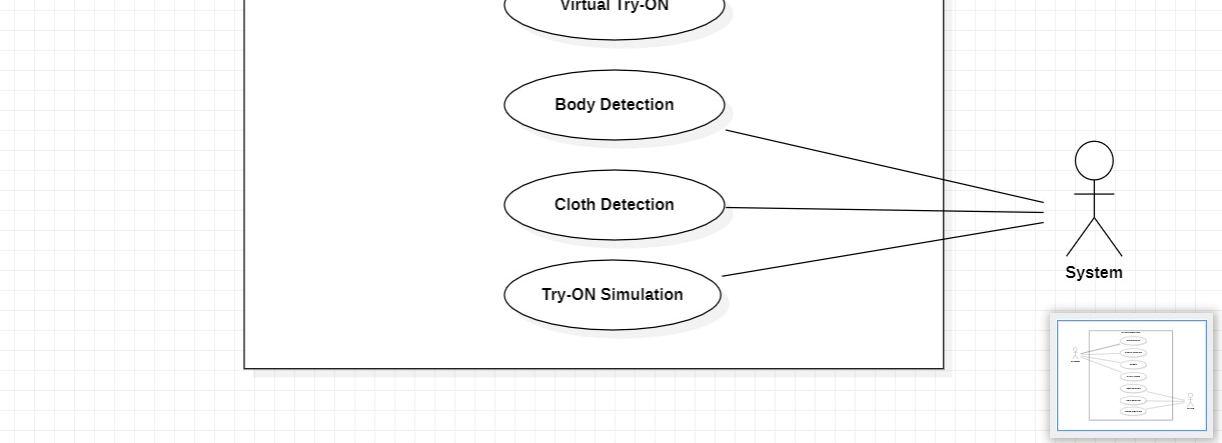
1) Developing a CNN model to visualize clothes trail through web cam.

2) Integrate both models and test the system with both images and videos.
3) The studyaims toestablish the virtual sizeandfittechnologyfeaturestoenhance fashion onlineretailingplatforms,utilizingdigital human measurements to the system.

The proposed system will facilitateto Customers can now virtuallytryon various types of products beforepurchasing them. order multiplevariations ofa singleproduct. What'simportanthereis that ARhelps customers avoid disappointmentand choosethe best products for them. As aresult, both onlineand brick-and-mortar storereturnratestend tofall. AP shortensthecustomerjourneyand increases store conversions regardless of whether the customer shops for items online or in-store.
Use case diagrams describe the high-level functions and scope of the system, these diagrams alsoidentifythe interactions between the system and its actors. A Use case diagram outlines how external entities user interact with an internal software system.
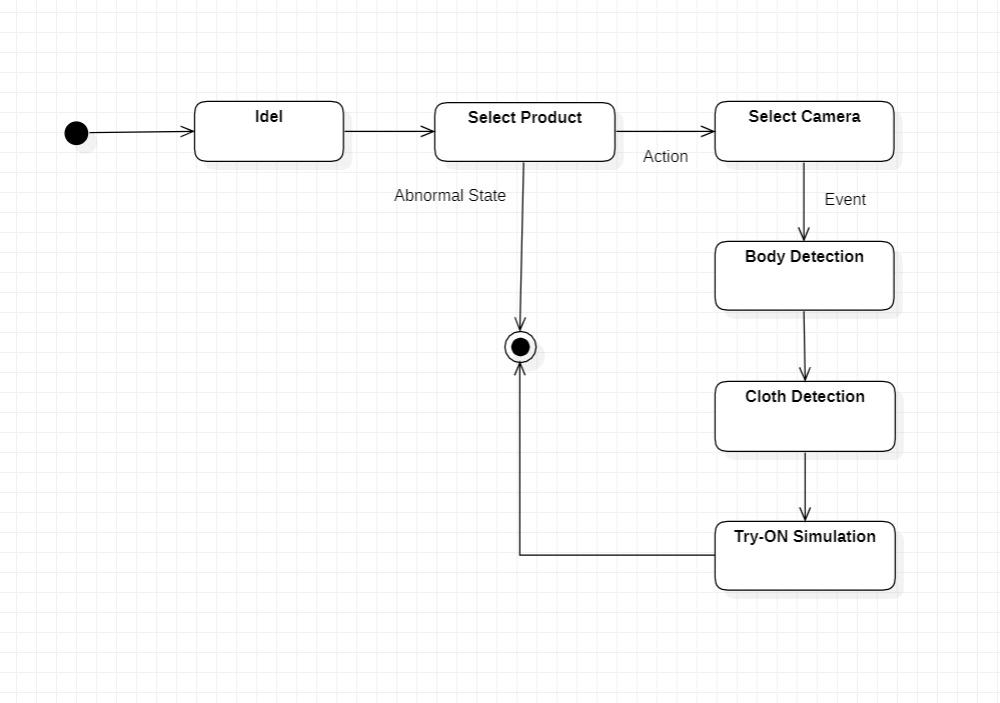
Astatediagramconsistsofstates,transitions,activities,andevents. Itdescribesthedifferentstatesthatanobjectmovesthroughorprovide an abstract description of the behavior of a system
Fig -2: State Diagram
ISSN: 2321-9653; IC Value: 45.98; SJ Impact Factor: 7.538 Volume 10 Issue XII Dec 2022- Available at www.ijraset.com

Activity diagrams are graphical representations of workflows with support for selection, repetition, and concurrency of step-by-step activities and tasks
Fig -3: Activity Diagram
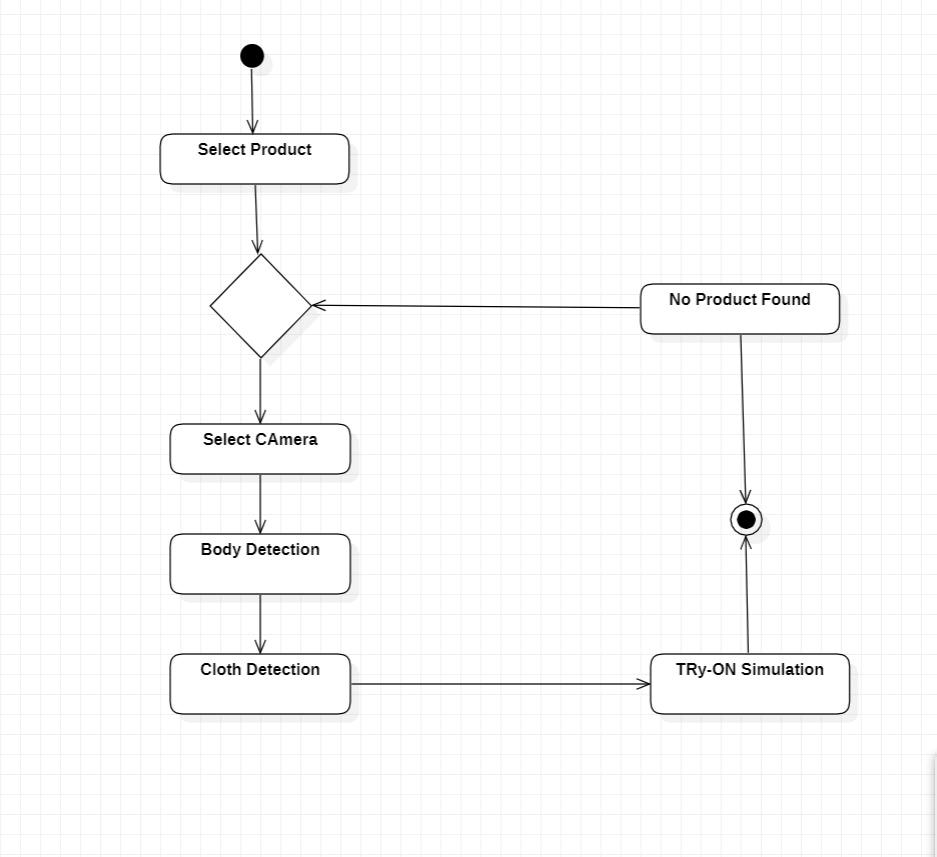
A design diagram explains how to build it. An architecture diagram describes what you're building.
Fig -4: Design Diagram
Sequence Diagramsareinteraction diagramsthatdetailhow operationsare carried out. Theycapturetheinteraction between objects in the context of a collaboration. Sequence Diagrams are time focus and they show the order of the interaction visually by using the vertical axis of the diagram to represent time what messages are sent and when.
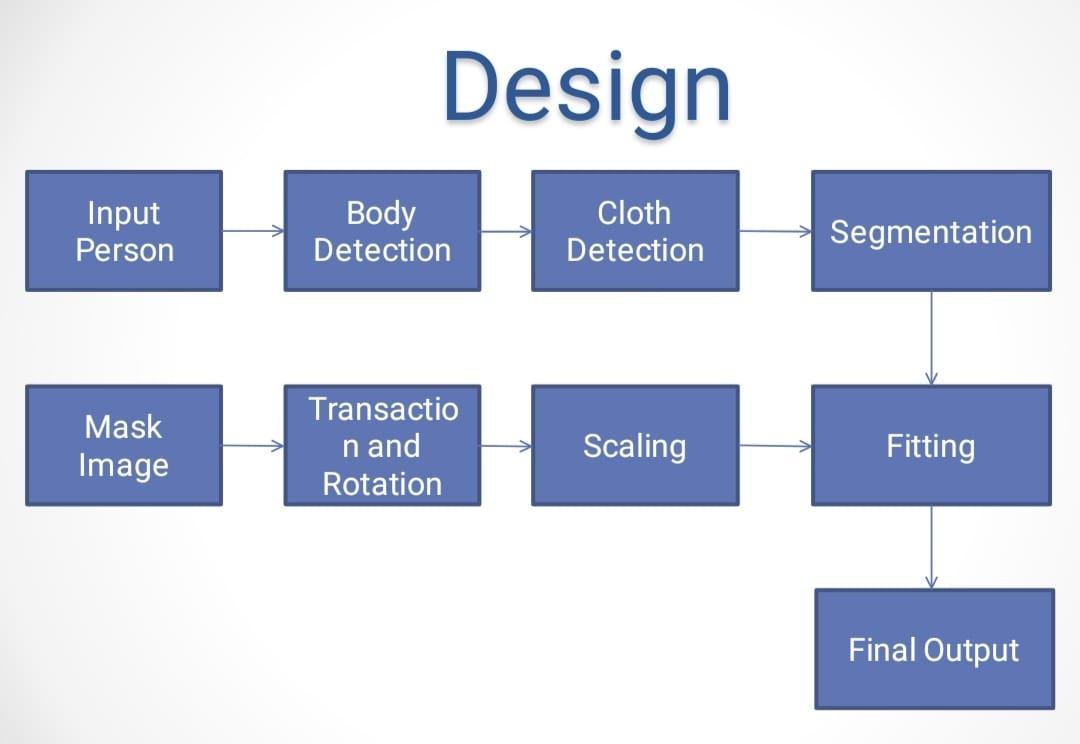
ISSN: 2321-9653; IC Value: 45.98; SJ Impact Factor: 7.538 Volume 10 Issue XII Dec 2022- Available at www.ijraset.com

Fig -5: Sequence Diagram
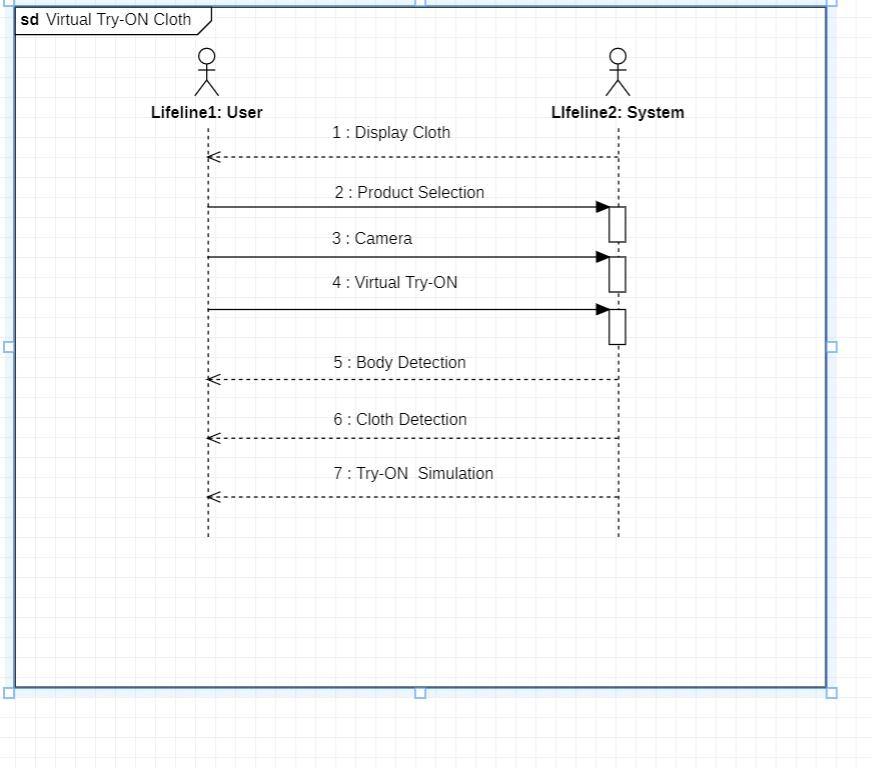
The future of fashion lies in customization and virtual try-on. With augmented shopping, customers will be able to configure their products in 3D, trying on different colors, styles and sizes to see what looks best. This will allow for a more personalized shopping experience, as well as give customers a better idea of what they’re buying. And with virtual reality, customers will be able to experience products as if they were actually wearing them.
This paper was supported byAlard College ofEngineering& Management, Pune 411057. We are verythankful toall those whohave provided us valuable guidance towardsthe completion ofthisSeminar Report on “EmailSpam Detection UsingMachine Learning”as part of the syllabus of our course. We express our sincere gratitude towards the cooperative department who has provided us with valuable assistance and requirements for the system development. We are verygrateful and want to express our thanks toProf. Prachi Nikelar for guiding us in the right manner, correcting our doubts by giving us their time whenever we required, and providing their knowledge and experience in making this project.
[1] Chao Lin, Zhao Li, Sheng Zhou, Shichang Hu, Jialun Zhan Linhao Luo, Yuan He (2022) RMGN: A Regional Mask Guided Network for Parser-free Virtual Try-on
[2] ChengJCP, ChenK,ChenW(2017)ComparisonofMarker-BasedandMarkerlessAR: ACaseStudyof AnIndoor DecorationSystem.In:LeanandComputingin ConstructionCongress -Volume1:ProceedingsoftheJointConferenceonComputinginConstruction.Heriot-Watt University, Heraklion, Crete,Greece, pp483–490
[3] Ge Y, Song Y, Zhang R, Ge C, Liu W, Luo P (2021) Parser-Free Virtual Try-on via Distilling Appearance Flows. In: 2021 IEEE/CVF Conference on Computer Vision and Pattern Recognition (CVPR). IEEE, Nashville, TN, USA, pp 8481–8489
[4] Groubert J, LanglotzT, ZollmannS, RegenbrechtH (2017)TowardsPervasiveAugmentedReality:Context-AwarenessinAugmentedReality.IEEE TransVisual Comput Graphics 23(6):1706–1724. https://doi.org/10.1109/TVCG.2016.2543720
